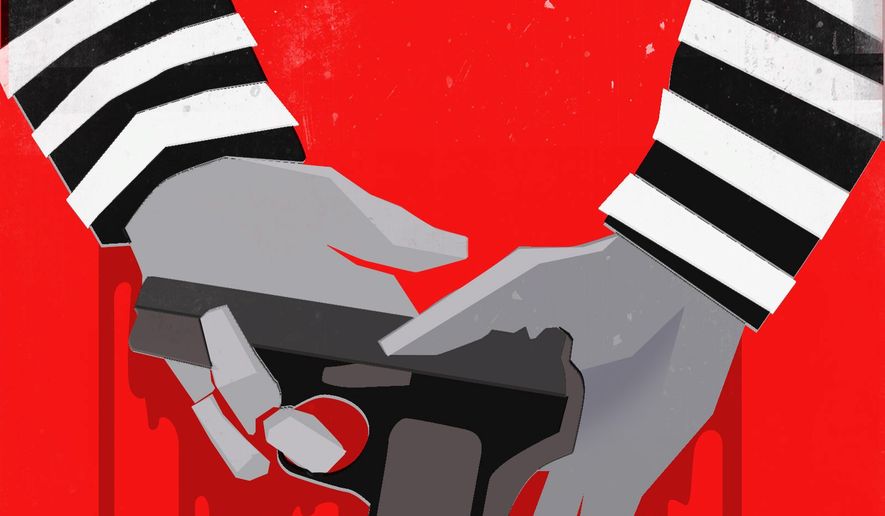OPINION:
While reading a Department of Justice report that states that fewer than 1 in 50 criminals obtained a firearm legally to use in the course of committing a crime, I thought of George V. Higgins’ classic 1972 crime novel, “The Friends of Eddie Coyle.’
The fictional character Eddie Coyle, a 45-year-old stocky career criminal, is a low-level gunrunner who purchases guns illegally and then sells those illegal guns to Jimmy Scalisi, the leader of a gang of violent bank robbers in Boston. The fine 1973 film adaptation of “The Friends of Eddie Coyle,” starring the late, great actor Robert Mitchum as Eddie Coyle, was faithful to the novel.
The late Mr. Higgins, a former newspaper crime reporter, was an assistant U.S. attorney in Massachusetts when he wrote his great crime novel. Mr. Higgins knew how hoodlums spoke, which is why the novel’s dialogue is so gritty and authentic. And he knew how they operated, which why his fictional armed robbers obtained their guns from an illicit source, namely Eddie Coyle, rather than a legal gun store.
Mr. Higgins knew that criminals didn’t go to retail stores and purchase firearms legally. One can’t imagine Eddie Coyle or Jimmy Scalisi taking the time to fill out the proper forms and then wait patiently for a background check prior to purchasing a gun. Both characters had extensive criminal records, which would in any case prohibited them from purchasing firearms legally.
One recent case illustrates how crime guns fall into the hands of criminals. Last August Bobby Perkins, Jr., a Fredericksburg, Virginia man, was convicted and sentenced to 12 years in prison for drug trafficking and illegally dealing 200 firearms.
At the time of the sentencing, Z. Zachary Terwilliger, the U.S. attorney for the Eastern District of Virginia, said that Perkins represented a danger to society through his pedaling of dangerous drugs and trafficking in illegal firearms.
According to the Justice Department, Perkins was in the business of dealing in firearms without a license. He acquired and re-sold more than 200 semi-automatic pistols. At least 93 of them were recovered by law enforcement, and some of them were found at the scene of homicides. Most of the firearms were recovered in Washington, D.C., while other guns were found in Maryland, Virginia, New York, New Jersey and Pennsylvania. According to the prosecutors, Perkins knew that many of the people he sold the guns to were convicted felons. Knowingly selling firearms without a license and selling firearms to convicted felons are federal offenses.
Just this month the Justice Department released a report called, “Source and Use of Firearms Involved in Crimes: Survey of Prison Inmates, 2016.” Based on a survey of prison inmates, about 1 in 5, or 21 percent, of all state and federal prisoners reported that they had possessed or carried a firearm when they committed the crime for which they were serving time in prison.
More than 1 in 8, or 13 percent, of all prisoners had used a firearm by showing, pointing, or discharging it during the offense for which they were imprisoned. Fewer than 1 in 50, less than 2 percent, of all prisoners had obtained a firearm from a retail source and possessed, carried, or used it during their offense. An estimated 287,400 prisoners had possessed a firearm during their crime.
Among these, the report continued, more than half, 56 percent, had either stolen it, found it at the scene of the crime, obtained it off the street, or from the underground market. The report states that 25 percent obtained a firearm from a family member or friend, or as a gift. Only 7 percent had purchased a firearm under their own name from a licensed firearm dealer
The report goes on to state that about 29 percent of state and 36 percent of federal prisoners who possessed a firearm during their offense intended to use the weapon during the crime. The report states 27 percent killed someone with it, 12 percent injured someone, 7 percent fired the gun, but did not injure anyone, and 54 percent did not fire it. Handguns were the most common type of firearm possessed by state and federal prisoners (18 percent each).
This report points out what any cop will tell you. Criminals mostly buy illegal guns from other criminals and they use these crime guns to rob, steal, rape and murder. I’m thankful that the Justice Department and local police departments are targeting professional criminals who sell firearms to other criminals. This, in my view, is true gun control.
State and federal legislators ought to read this report, as well as “The Friends of Eddie Coyle,” and concentrate their efforts on removing illegal guns from the hands of criminals, rather than attempt to restrict the rights of legal gun owners.
* Paul Davis is a writer who covers crime, espionage and terrorism.




Please read our comment policy before commenting.